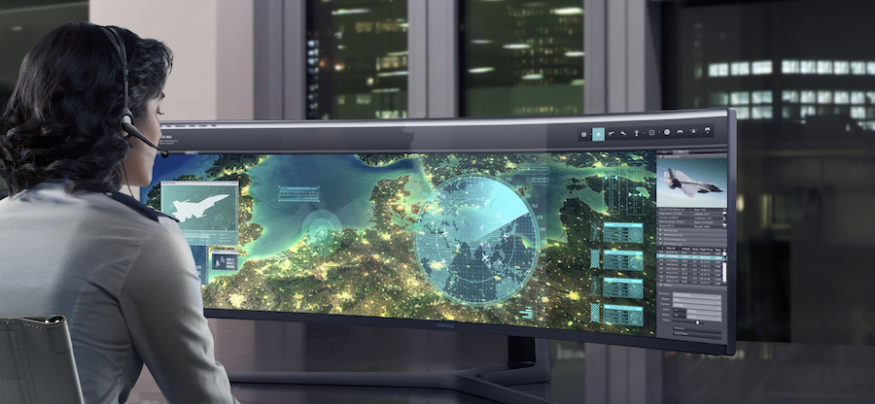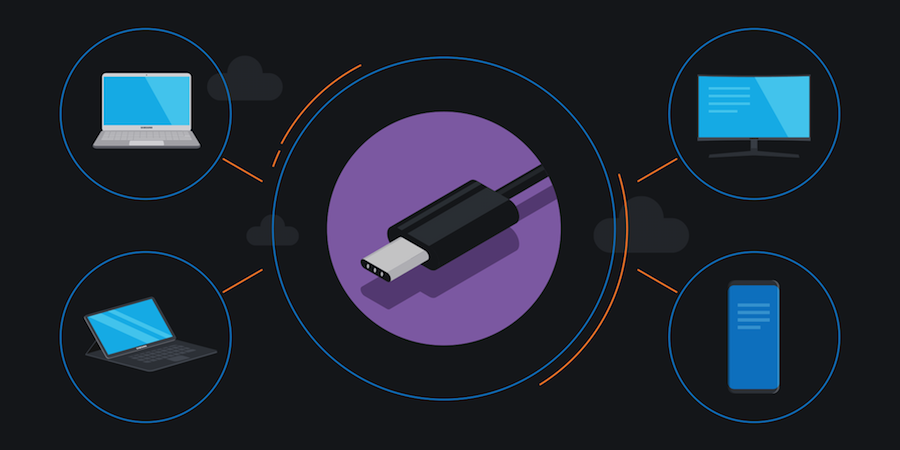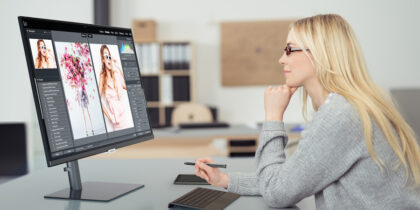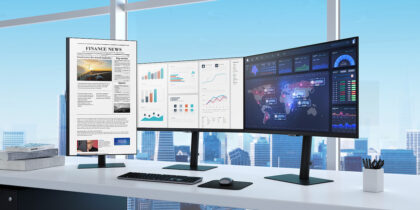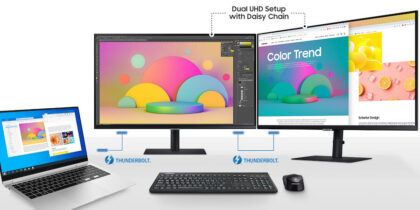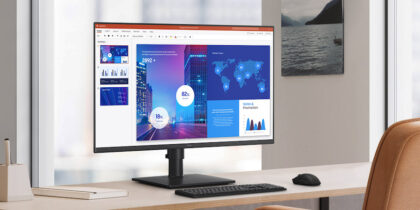Casual observers might regard ultra-wide curved monitors as an extravagance, but the people using them for everything from business to gaming would beg to differ.
To them, the extra screen real estate and immersive viewing experience that a big screen delivers are essential to what they do. Along with the simple benefit of getting a truly big picture on whatever they’re doing, ultra-wide monitors deliver on several other tangible advantages.
Let’s look at the case for putting ultra-wides on a desk, as well as some cautionary notes about ensuring the investment pays off.
The Big Picture
Gamers who spend hours immersed in the video games they love are sure to welcome the sprawling canvas of an ultra-wide monitor. The curved screen does a better job of immersing players in the same way headsets do over typing. Their field of view is increased, boosting peripheral vision and potentially giving them an advantage in multiplayer games. It’s a premium experience that fits their lifestyle and interests.
People in workplaces might also like to put their heads down and get lost in their assignments, but the bigger advantage for screens in business environments is the ability to multitask without compromise.
Few people in working environments — particularly in offices — do one thing all day. Typically, they’re going to have an email application open, a browser with multiple tabs, office productivity software and collaboration tools for interoffice messaging. It’s a lot to fit on a normal desktop monitor, never mind the portable laptops many people now use.
The Complete Guide to USB Type-C
Learn how to clear desk space, streamline workflow and save time and money with USB-C connectors. Download Now
The traditional fix for dealing with a lot of information on screen at once is to add more monitors — pairing or even tripling monitors side-by-side to extend the computer’s visual workspace. That works, certainly, but each monitor has a noticeable frame, and when those frames are butted against each other, there are large vertical bands bisecting that overall display surface. It’s like looking out a window that has bars. Any open applications need to fit within those individual monitor spaces, which can neuter some of the benefits of an ultra-wide desktop.
Samsung’s CHG90 49-in. curved monitor is the equivalent of two 27-inch displays side by side, delivering a 32:9 aspect ratio. Most wide displays are just 21:9.
For creatives who develop everything from online games to special effects for Hollywood, an ultra-wide surface allows them to develop and see work in full-screen, native formats, and to review long and wide timelines for the layers of effects and elements that are part of their work. Similarly, any accountant working on elaborate spreadsheets or a project manager developing extensive Gantt charts will benefit from as much horizontal screen space as they can get to fully see their work and plans.
Practical Value
Like sheer size, the curved aspect of these monitors may look at first pass like an extravagance that’s more about bragging rights among friends and colleagues. However, they’re also ergonomic — easier on the eyes because the curves bring the far edges of the screen to roughly the same viewing distance as the center. With a wide but flat monitor, users’ eyes are having to constantly adjust to varying focal lengths — particularly when playing fast-paced, visually chaotic games. With a curved screen, your eyes don’t have to work so hard.
Research bears that out. Testing by TUV Rheinland found 87 percent of people who tried a curved monitor found they created a more comfortable experience, and a Harvard Medical School study tested flat and curved monitors and found that fewer test subjects reported eye strain on the latter.
The workspace is also decluttered when one monitor replaces two or more. With an ultra-wide monitor, there’s one power cable. Displays that fully support the USB-C protocol can use a single cable connecting a laptop to the monitor to send the signal and commands to the screen, but the screen can steadily power and charge that laptop, meaning there’s no power brick required. The screen can also act as a USB hub, with peripherals plugged in its rear, instead of the PC or a costly docking station or external hub. This makes for a tidier workspace, quick and easy connects and disconnects, and lower capital costs.
In addition, those pesky bottom scroll bars for software applications get far less use, if they show up at all, when an ultra-wide screen is used.
Specs Matter
Beyond the size and shape of an ultra-wide monitor, the specifications provide an optimized viewing experience.
- Brightness: In practical terms, a brighter screen is easier on the eyes in environments with a lot of ambient lighting. But high brightness (Samsung’s CHG90 delivers 600 nits at peak) ensures viewers get the full benefits of High Dynamic Range (HDR). They see the complete range of visual detail in the darkest or brightest settings.
- Color reproduction Samsung’s 49-inch monitor has been enhanced with a quantum dots (QLED) layer, a film that boosts the color space to rich, true-to-life levels not seen on standard monitors.
- Speedy and smooth performance: Whether rendering video or motion graphics at an advertising agency or displaying a fast-paced online multiplayer game, a high-performing monitor needs a screen refresh rate of at least 120Hz (which the CHG90 tops at 144Hz), along with built-in technology like AMD FreeSync 2 to minimize image lag and motion blur.
- Viewing enhancements: Samsung’s 49-in. ultra-wide screen has a mode that reduces fatigue-inducing blue light emissions and suppresses distracting screen flickering.
Going Big
Not all screens are alike — even if they have the same shape. What’s happening behind the scenes also matters.
An ultra-wide monitor like the CHG90 has a super high display resolution of 3840×1080 pixels. Does the PC workstation or laptop support that resolution? The signal will show up on the screen regardless, but the visuals might be stretched if not supported.
For applications other than gaming and creative production, resolution is less of an issue because several windows will likely be open on a screen to allow multitasking.
Users will also want to pay attention to what’s plugged into the screens and supporting them. While more and more monitors feature USB-C connectors, not all of them meet the standard. With some, you may think the monitor will replace the need for a docking station, and then discover it does not support accessories like bidirectional cables that send signals and commands into the screen, and power back out to a laptop.
If you have the physical space in the office or at home, an ultra-wide, immersive display will allow you not only to do more, but to more fully focus on the task — or game — in front of you.
Learn about USB-C and other Samsung monitor capabilities with this free white paper, or see Samsung gaming monitors in action in this episode of Samsung Business Television.
